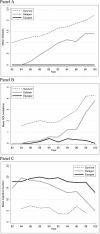Becoming centenarians: disease and functioning trajectories of older US Adults as they survive to 100
- PMID: 25136001
- PMCID: PMC4311187
- DOI: 10.1093/gerona/glu124
Becoming centenarians: disease and functioning trajectories of older US Adults as they survive to 100
Abstract
Background: Little is known about the health and functioning of individuals who become centenarians in the years prior to reaching age 100. We examined long-term trajectories of disease, disability, and cognitive function in a sample of U.S. centenarians to determine how their aging experience differs from their nonsurviving cohort counterparts, and if there is heterogeneity in the aging experience of centenarians.
Methods: Data are from the 1993-2010 waves of the nationally representative Health and Retirement Study. Among those who had the potential to become centenarians, we identified 1,045 respondents who died before reaching age 100 and 96 who survived to their 100th birthday. Respondents, or their proxies, reported on diagnosis of six major diseases (hypertension, heart disease, lung disease, stroke, cancer, and diabetes), limitations in activities of daily living, and cognitive function.
Results: As they age to 100, centenarians are generally healthier than nonsurviving members of their cohort, and a number of individuals who become centenarians reach 100 with no self-reported diseases or functional impairments. About 23% of centenarians reached age 100 with no major chronic disease and approximately the same number had no disability (18%). Over half (55%) reached 100 without cognitive impairment. Disease and functioning trajectories of centenarians differ by sex, education, and marital status.
Conclusions: While some centenarians have poor health and functioning upon reaching age 100, others are able to achieve exceptional longevity in relatively good health and without loss of functioning. This study underscores the importance of examining variation in the growing centenarian population.
Keywords: Centenarians; Disease; Functioning.; Longevity.
© The Author 2014. Published by Oxford University Press on behalf of The Gerontological Society of America. All rights reserved. For permissions, please e-mail: journals.permissions@oup.com.
Figures




References
-
- U.S. Census Bureau, 2010. Census Special Reports. Centenarians: 2010. Washington, DC: C2010SR-03, U.S. Government Printing Office; 2012.
-
- Bell FC, Miller ML. Life Tables for the United States Social Security Area, 1900–2100. Baltimore, MD: Social Security Administration, Office of the Chief Actuary; 2002.
-
- Projections of the Population by Age and Sex for the United States: 2010 to 2050 (NP2008-T12). Washington, DC: Population Division, US Census Bureau; 2008.
-
- Olshansky SJ, Rudberg MA, Carnes BA, et al. Trading off longer life for worsening health: the expansion of morbidity hypothesis. J Aging Health. 1991;3:194–216. :10.1177/089826439100300205
-
- Andersen-Ranberg K, Schroll M, Jeune B. Healthy centenarians do not exist, but autonomous centenarians do: a population-based study of morbidity among Danish centenarians. J Am Geriatr Soc. 2001;49:900–908. :10.1046/j.1532-5415.2001.49180.x - PubMed
Publication types
MeSH terms
Grants and funding
LinkOut - more resources
Full Text Sources
Other Literature Sources
Research Materials

